0 INTRODUCTION At present, domestic bus reporting methods use manual reporting stations, but because drivers need to report on the premise of ensuring safe driving, there are often a series of problems such as misstatement, underreporting, and security risks. The use of GPS global positioning system for automatic reporting makes this problem easy to solve, without manual intervention, greatly reducing the workload of the driver, while also improving the safety of vehicle operation and promoting the modernization of the public transportation system.
At this stage, the information screens in the bus are mostly obtained by means of wired information such as news, weather reports, advertisements, etc., and the information of the station can also be displayed simultaneously. However, there is an inevitable problem, that is, because there is no integrated GPRS wireless communication function, it is more troublesome to maintain. If you need to change the advertising content, you must send a large number of personnel to the information screen of the bus that needs to change the advertising content. Change, wasting a lot of manpower and resources. The application of GPRS enables the system to achieve an unprecedented high level of integration, and solves the shortcomings of the current domestic information update methods in the bus. Through the GPS satellite positioning system and the GPRS wireless communication network, the bus monitoring and dispatching center can monitor the distribution of the bus position of each line in real time, and issue a dispatch notification to the relevant bus according to the monitoring situation.
This article refers to the address: http://
1 The composition of the bus automatic reporting system The system consists of terminals (information screen, waist card, etc.), automatic station station, GPRS/GSM communication network and bus monitoring and dispatching center. The automatic station is mainly composed of a main control chip, a GPS/GPRS communication module, an LCD, an SD card, and an MP3 decoding chip. The overall structure of the entire system is shown in Figure 1.
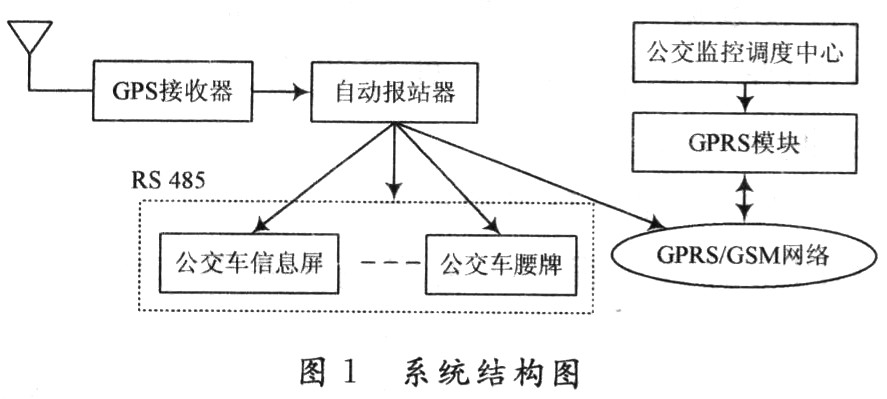
The automatic station reporter uses the self-learning function to store the latitude and longitude information of the site to the SD card. When the bus travels to a certain site, the received latitude and longitude information is consistent with the stored latitude and longitude information of a certain site. The station name of the corresponding site is automatically broadcasted, and the following two functions are implemented:
(1) Send the corresponding information to each terminal in the vehicle through the RS 485 interface to realize the control integration within the bus;
(2) Send the status information (latitude, longitude, latitude, speed, etc.) of the bus to the bus monitoring and dispatching center through the GSM network to achieve a high degree of uniformity between the bus and the monitoring and dispatching center.
2 The hardware design of the bus automatic report station The bus automatic report station mainly uses the LM3S1601 main chip, GPS module and GPRS module as the core to build the terminal platform. They are connected by serial communication, and the rest also includes the power supply mode. MP3 player interface and SD card interface. The schematic diagram of the hardware principle is shown in Figure 2.
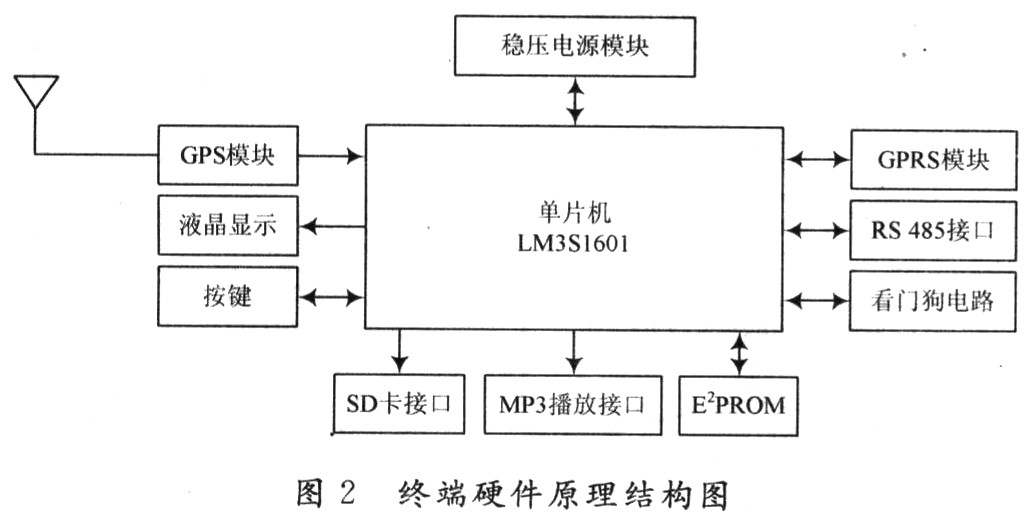
2.1 Power Module Design The power system has a great influence on the reliability operation of the automatic station. A good power circuit can filter out many interference signals transmitted through the power circuit. The power supply circuit of this power module is shown in Figure 3.

The controller input voltage is 24 V. Since the peak current of GPRS Internet access can reach 2 A, the power chip uses LM2596-5.0 and the output current can reach 3 A. The LM1117-3.3 chip is used to supply power to the LM3S1601, SD card, etc., the LM1117-2.5 chip supplies power to the MP3 decoder chip, and the MIC29302 chip outputs 4 V voltage to the GPRS module.
2.2 SIM300C GPRS module SIM300C embedded TCP/IP protocol stack, based on GSM/GPRS900/1 800/1 900 MHz tri-band, adopts dual in-line board-to-board connection, suitable for vehicle applications. Dimensions: 50 mm × 33 mm × 6.2 mm. Support class2, controlled by AT command, meets GSM 2/2+ standard, with RS 232 level, directly connected to the single chip microcomputer.
2.3 The main control chip adopts TI's LM3S1601 single-chip microcomputer as the control main chip. The chip adopts ARM Cortex-M3 core. Cortex-M3 is ARM's latest ARMv7-based processor core, which has high performance and low cost. Low power consumption. It uses a Harvard architecture, using separate instruction and data buses (with a bus under the von Neumann structure, data and instructions), and the processing speed is significantly faster. The Cor-tex-M3 only supports the latest Thumb-2 instruction set. Eliminating the switching between Thumb and ARM code, the Cortex-M3 core integrates an interrupt controller that provides basic 32 physical interrupts with 8 levels of priority, up to 240 physical interrupts and 256 interrupt priorities. This type of design is deterministic and has low latency, making it ideal for automotive applications. With 128 KB of on-chip FLASH, 32 KB of on-chip SRAM, 3 UART serial ports, 2 SSI interfaces, and 2 I2C interfaces, it can fully meet the needs of today.
2.4 E2PROM and SD card storage module The E2PROM model is CAT24C02, which is used to store the necessary data such as the station number, line, uplink and downlink, and mode of the station, to prevent loss of power loss data. The SD card stores Chinese station name, latitude and longitude information, MP3 audio file, etc. The SD card and the single-chip computer communicate through the SS10 interface, and adopt the FAT16 format file system to support the SD card of up to 2 GB.
2.5 MP3 decoder chip MP3 decoder chip is the VS1003 chip produced by VLSI Solution of Finland. VS1003 is a single-chip MP3/WMA/MIDI audio decoding and ADPCM code chip, which has a low-power DSP processing. Core VS_DSP, 5 KB of instruction RAM, 0.5 KB of data RAM, serial controller and data input interface, 4 general purpose I/O ports, 1 UART port; simultaneous with a variable sample rate ADC, a stereo DAC, and headphone audio amplifier.
3 The software design and implementation of the bus automatic report station is realized by the single-chip microcomputer LM3S1601 to realize the reception and processing of GPS information, GPRS Internet access, connection establishment, receiving data, MP3 voice file playback, reading and writing of SD card content, LCD screen display, etc. Features. The working process of the system is roughly as follows: self-learning of the site through the reception of buttons and GPS information; automatic search of the site, and automatic reporting: if the latitude and longitude information received by the GPS module is consistent with the stored latitude and longitude information of a certain site, then SSI0 is passed. Read the corresponding MP3 file from the SD card, send the read data stream to the VS1003 player through SSI1, display the corresponding station number and station name on the LCD screen, and send the current address through the GSM network. The latitude and longitude information is sent to the bus monitoring and dispatching center to realize the function of automatic station reporting; the center actively connects to the automatic station station, and the automatic station device performs different operations according to the received communication protocol (such as real-time monitoring, in-vehicle information update, etc.) . The software component block diagram of the system is shown in Figure 4.
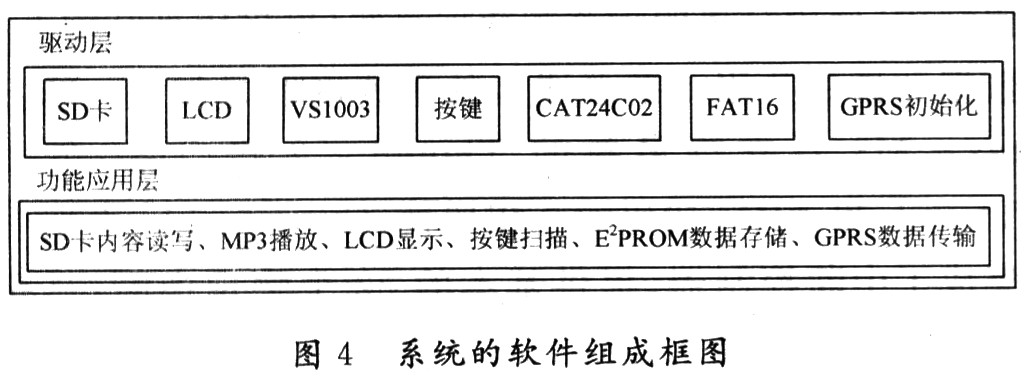
3.1 Main program design of the station program The main program mainly completes the system initialization and the calling of each module subroutine. The flow chart is shown in Figure 5.
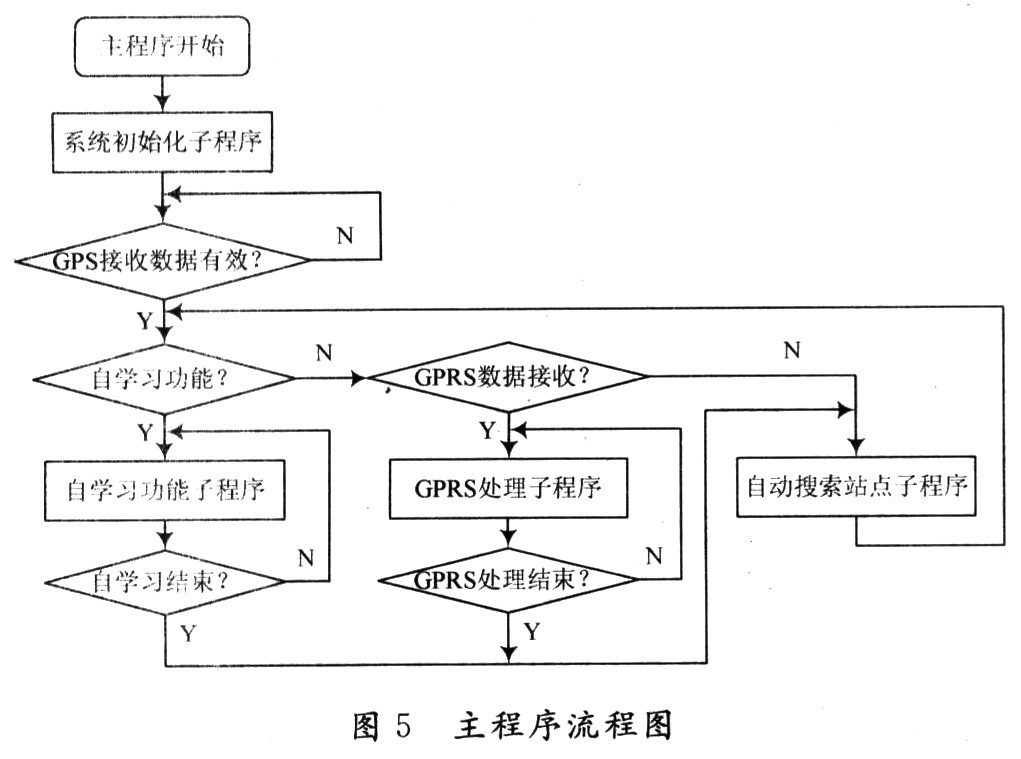
The system is initialized after power-on, including: I/O port, timer, UART, watchdog, module (SD card, GPRS module, VS1003, etc.). After the system is initialized, it receives GPS positioning information and has more GPS communication protocols. The program uses the most widely used NMEA-0183 protocol. The format includes "$GPGGA", "$GPGSA", "$GPGSV" and "$GPRMC", and this article uses the simplest format "$GPRMC" statement. The format is as follows: $GPRMC, <1>, <2>, <3>, <4>, <5>, <6>, <7>, <8>, <9>, <10>, <11>, <12>*hh where <2> is the positioning state, A=effective positioning, V=invalid positioning, when the receiving data is A, the GPS receiving data is considered valid, then the self-learning function, GPRS processing function, automatic search site Function judgment and processing.
3.2 Design of GPRS processing subroutine The GPRS processing subroutine mainly realizes the communication, monitoring scheduling and information updating function between the station and the center.
The center calls the notice station to go online, and the station receiver receives "+CLIP:" 020********", 129", hangs up the call through "ATH" to determine whether it is a central call, and if so Establish a PPP connection. After the connection is successful, connect the fixed IP address and port number of the center through TCP/IP.
After the station station and the center are successfully connected, the two parties send handshake commands to each other. If the "handshake" is successful, communication is performed; otherwise, the center actively disconnects the network. After the "handshake" is successful, the station receiver receives the instruction issued by the center. If it is a "real-time monitoring" command, the GPS data is sent in real time. In order to prevent the network from disconnecting between the center and the station, both parties need to send a "heartbeat packet" periodically; if it is an "information update" command, the receiving center sends the update information. Automatically disconnected after receiving.
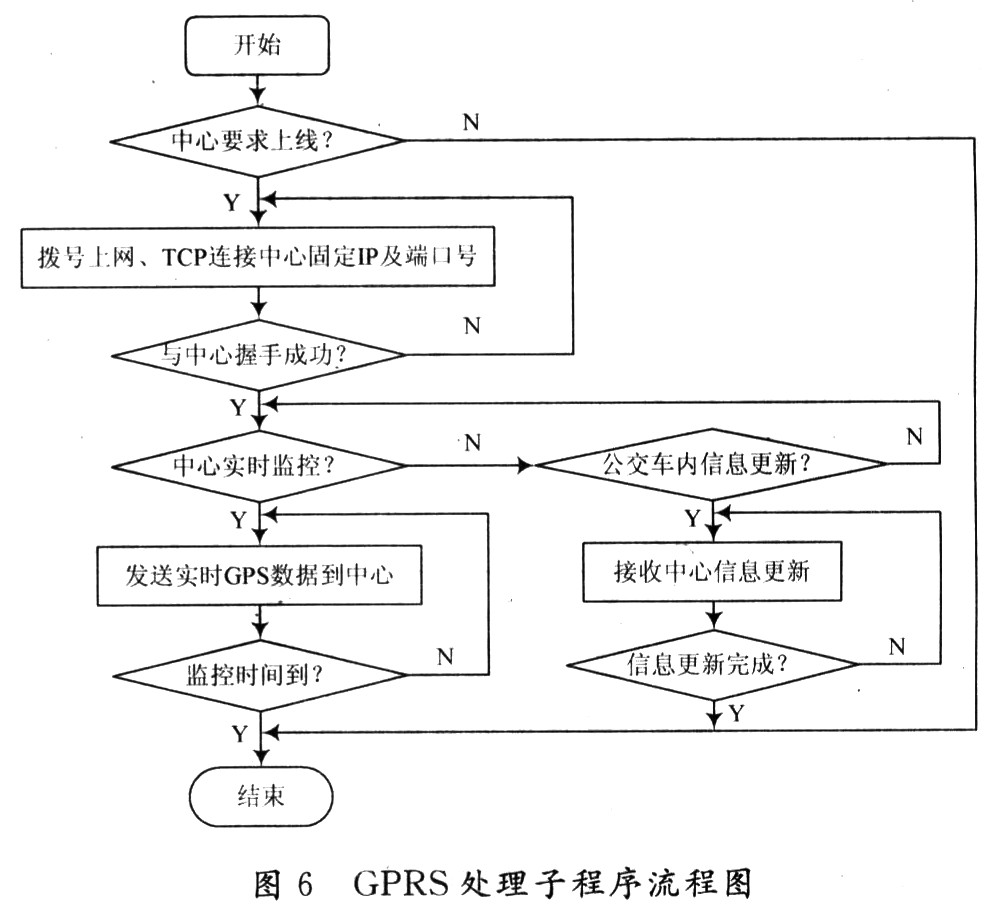
4 Conclusion The automatic station reportr passed EMC and reliability test and on-site trial operation. The system functions normally, runs stably, exhibits strong anti-interference ability and high reliability, especially the GPS automatic report function, according to the customer. Needs and the actual situation of the bus line to change the scope of the station and forecast station, to ensure the accuracy of the station, improve the safety of the bus, reduce the burden on the driver, and have good social and economic benefits. At present, the system functions are undergoing the improvement of some advanced functions, and the industrialization work is also in full swing.
Solar Double-ended Brush,Solar Panel Cleaning System Tool,Solar Panel Cleaning Brush
GuangZhou HanFong New Energy Technology Co. , Ltd. , https://www.hfsolarenergy.com
